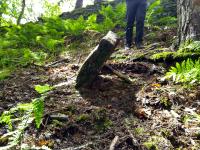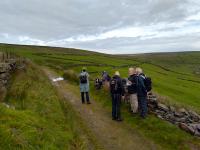Ted Hughes' Calder Valley
Share this page

I’m standing by the twin stones of Abel Cross with a group of half a dozen others. We are all bowed in cagoules as the wind and rain are driven insistently across the edge of this moor above Shackleton. Nick is reading Ted Hughes’ poem Abel Cross, Crimsworth Dean and, while it may be appropriate content for this place, it does not seem the right time for a poetry reading. I am getting soaked to the skin and the map I am trying to draw is turning to a pulpy mush. He launches into the story of Oxenhope Jack and Heptonstall Jim, the two swains who fought over Katie of Cross Ends and ended up slaying the other in a bloody duel. Katie is said to have buried the pair of them here as they were denied a Christian burial, before hurling herself into Lumb Falls and ending up being buried between the two. It is a fascinatingly macabre tale, but I am unable to make notes and long only for the sanctuary of the ravine.

Ted Hughes's Yorkshire
I’m here with the proponents of Ted Hughes’s Yorkshire, who have commissioned me to produce three walking leaflets exploring the Calder Valley of his youth. I don’t admit to not being a massive Hughes fan but, as the day wears on and we walk the landscape through this particular lens and read his Elmet poems in the places that inspired them, his words start to grow on me. It may be just a line or two here or there, but it is enough to appreciate his unique view of a place that no longer exists. Gentrified Hebden Royd is a world away from the smoky den of the 1930s, which Hughes thought was dying on its feet. It is strange then that he returned in 1969, buying the house at Lumb Bank in Colden Clough that he had for many years dreamed of owning. He lived there for just a few months, the Calder Valley unable to live up to his vision of it, but its landscape fascinated him throughout his life.

The Calder Valley
We devise three walks in the Calder Valley, one based around his childhood home in Mytholmroyd, one his later home at Lumb Bank and the other his youthful camping experiences in Crimsworth Dean. They are short, straightforward walks by my standards, but designed to introduce new people to this special landscape and full of interesting details. Many of Hughes’ Elmet poems are named after local landmarks – Heptonstall, Colden Water, Slack, Churn Milk Joan, Shackleton Hill, Mount Zion, etc, but there are surprisingly specific places that can also be pinpointed. The Sheep Went On Being Dead was inspired by a sheep carcass on the bend at the top of Hill House Clough just below Heights Road. The sheep carcass may not be there, but the mound in Redacre Wood that he cited in The Ancient Briton Lay Under His Rock is still evident and everyone gets excited when we go hunting for the Deadfall Stone mentioned in his ghost story The Deadfall. It is a rough scramble up the bank above the nameless quarry (not Great Mount Quarry as I had quoted in my book) where Ted and his brother camped in 1937, but near the top we discover a large rock that can only have formed the trap in which they found a snared fox. We have been guided to it by a map from Ted’s brother, Gerald, from America via their old friend Donald Crossley. It is large and flat, but just light enough to lift up and support with a wooden truss, so we recreate this ancient trap and stand proudly around it like the young hunters Ted and Gerald, though I’m sure we would be as traumatised if we trapped a fox as young Ted was.
Find out more about the Ted Hughes’ Yorkshire project at http://mhm.hud.ac.uk/tedhughes/. The leaflets will be available in the coming months.
